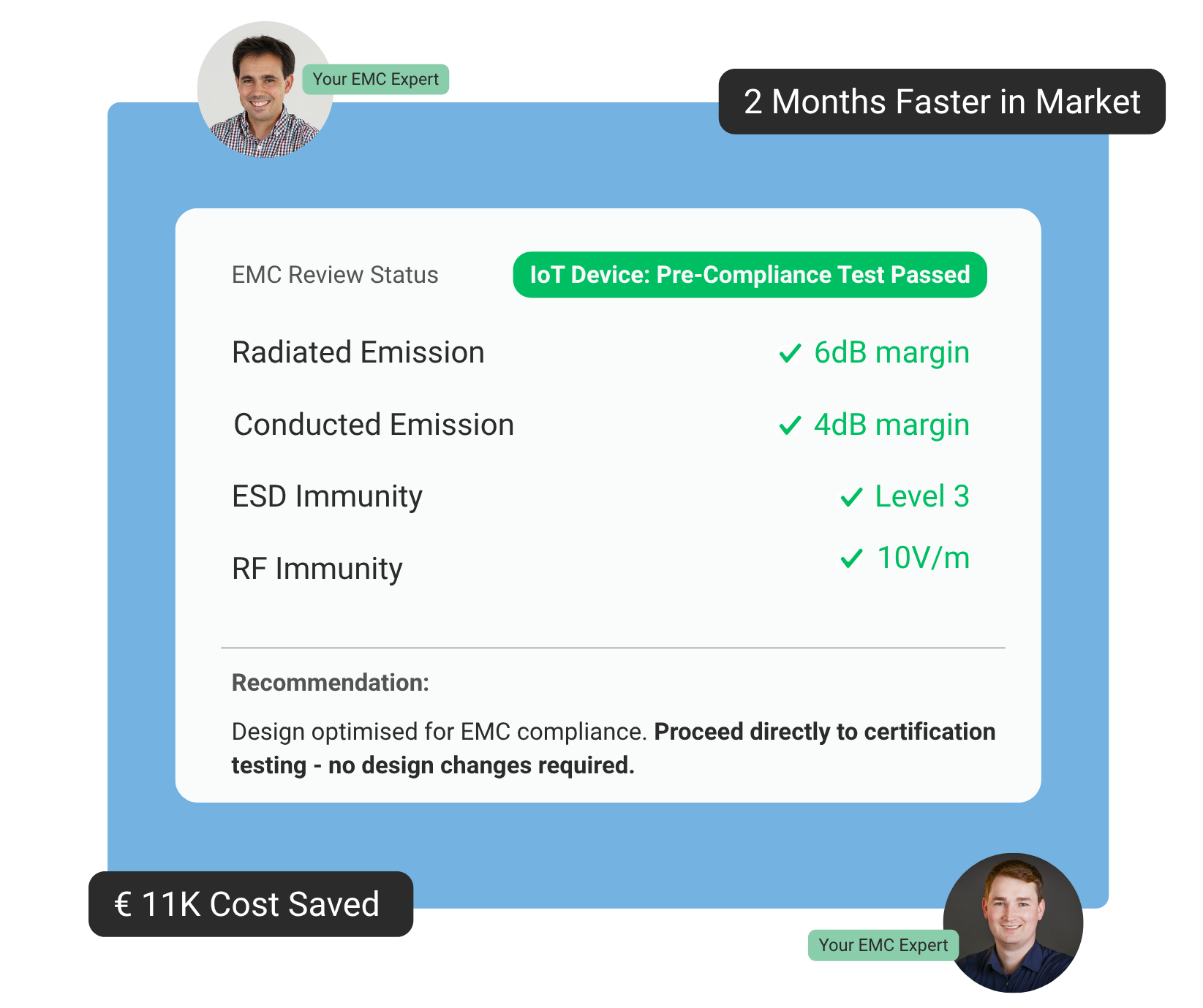Let's fix your expensive EMC/EMI problems.
DENPAFLUX delivers on-demand EMC expertise and has completed 400+ successful EMC analysis reports, helping hardware teams dealing with EMC/EMI issues in their development projects successfully pass EMC testing and launch products faster to market.

Experience DENPAFLUX Way to Solve your EMC Challenges
See how DENPAFLUX helps electronics design teams to eradicate EMC issues faster & easier by providing iterative consultation as of the early product development cycle with our AI-infused EMC service.
Why EMC becomes a nightmare ?
Every hardware team faces the same EMC crisis & predictable problems in their projects:

Late-stage EMC failures
Your prototype fails EMC testing just weeks before launch. Panic sets in as you face board redesigns and schedule delays.
Multiple expensive respins
Each PCB respin costs $20K-200K+ and weeks of time. Without EMC expertise, you're shooting in the dark.
Critical time to market pressure
Competitors are launching. Every day counts. But EMC failures force you into reactive 'metal walls and ferrites' fixes.
EMC experts are impossible to hire
Good EMC engineers are rare, expensive, and already employed. Building this expertise in-house takes years you don't have.
Sounds familiar ? You are not alone.
Every hardware team faces the same EMC crisis & predictable problems in their projects
70
%
4
weeks
50
%
How DENPAFLUX works ?
On-demand EMC expertise that scales with your needs. Get expert reviews, lab coordination, and design guidance without the overhead of hiring.
3 Business Days
Upload your design files. Get expert analysis and recommendations within 3 business days*. No waiting, no scheduling conflicts.
Detailed EMC Report
Every engagement includes detailed root-cause and EMC design principles. Your team learns while solving current problems.
One Subscription.
No hourly rates. Get EMC Expertise & Services at a fixed monthly or yearly plan. No hidden fees, no hiring headache. Just results
Customer Success Story:
How Alfen Built EMC Expertise While Accelerating Hardware Development?
Discover how DENPAFLUX helped Alfen maintain EMC design quality while increasing hardware development velocity.

For Industries Who Can't Afford EMC Surprises.
Medical Device EMC
Consumer Electronics & IoT
RF & Wireless Products

Power Electronics
Industrial Equipment
Aerospace & Space Tech
EMC is hard. Finding an expert shouldn't be.
DENPAFLUX provides on-demand EMC expert access based on your project's EMC challenges. No hiring. No Hourly Fees.
0
+0
+0
+0
+EMC Services Across Your Entire Product Cycle
Most teams discover EMC problems at testing. By then, it's too late and too expensive. We catch issues where they start and fix them before they cascade.
EMC Specifications
Define real EMC requirements: Class A vs B limits, ESD/EFT/surge levels, radiated vs conducted budgets. We translate compliance standards into actual design constraints your engineering team can implement.
System Architecture
Review your system partitioning, grounding topology, and shield planning. Catch split ground plane disasters, identify missing return paths, validate your star vs multipoint grounding before you spin boards.
Design
Schematic deep-dives: decoupling strategies, ferrite bead placement, TVS diode selection, common-mode choke specs. Stack-up reviews: layer assignments, reference plane continuity, controlled impedance planning.
Validation
Pre-compliance debug support: identify your noise sources that switching regulator at 500kHz, the unterminated stub radiating at 2.4GHz, the ground loop coupling into your analog front-end.
Launch
EMC Compliance testing: cross-talk analysis, cable radiation assessment, chassis resonance identification. Debug why your perfect subsystems fail when integrated. Solve ground bounce, fix power supply coupling, eliminate cable-to-cable crosstalk.
In-Field
Field failure forensics: component substitution impacts, firmware changes that broke EMC, manufacturing variations causing marginal passes to become fails. Emergency ECO support.
Built for Secure Data Design Handling
Hardware teams trust DENPAFLUX to keep design data secure from upload to certification. Every schematic, PCB file, and EMC report is encrypted, compliant, and protected—so your IP stays yours.

SOC2 Data Encryption
Data encrypted in transit and at rest on secure German servers (Frankfurt) with ISO 27001/SOC 2 certified providers.

Your IP is Protected
Your design data remains confidential and stays your intellectual property.

GDPR Compliant
Full European data protection compliance. You can request secure deletion of your project data at any time.
Lets get in touch!
Ready to Prevent Your Next EMC Disaster?
Join engineering teams all around globe who trust DENPAFLUX to catch EMC issues before they become expensive problems.
What engineering teams say

Thanks to DENPAFLUX, we were able to identify and fix potential EMC issues early in the design process, allowing our engineers to fast-track iteration and fewer re-spins on designs which saved us a lot of time and money down the road.
One of the biggest benefits of working with DENPAFLUX was their easy-to-understand and concrete mentions in the report. EMC recommendation reports were classified by severity, making it easy for us to understand the findings and take action on them. We couldn't be happier with the results.

DENPAFLUX prompted our team of design engineers to thoroughly revisit and analyse the specific design elements in question, resulting in enhanced rationale for our design decisions They empowered us to achieve optimal solutions and strengthen our design process!
To ensure that we don’t lose months
to a redesign we use DENPAFLUX to check for possible EMC problems. Having another AI-powered pair of eyes meticulously checking every circuit will always be beneficial. The knowledge and best practice techniques learned from the detailed reports also help us in avoiding certain error sources from the get-go.
Worried about IP rights ?
Our digital NDA takes less than 1 minutes to complete.
Self-sign your NDA and share your electronic design projects confidently and get personalised EMC guidance from our experts.
Frequently Asked Questions About DENPAFLUX
How does the process of working with DENPAFLUX typically works?
DENPAFLUX is simple and efficient. We start with a no-obligation call to understand your EMC challenges. Based on this, we create a customized plan aligned with your chosen package that includes design reviews, consulting, EMC testing, and access to our platform. Upon completion of the initial purchase order or payment, you'll have immediate access to our platform and services, allowing you to promptly address your EMC requirements.
What kind of design file you need to work with DENPAFLUX?
DENPAFLUX accepts all major CAD software files, including Altium, KiCad, and Eagle. We also work with schematic diagrams, system-level designs like cabling, and even PDFs. We easily integrate with your current workflow, enhancing your existing processes without disruption.
How does DENPAFLUX ensure the confidentiality of our designs when we upload them for analysis?
We take your intellectual property very seriously. All design files are secured during transmission and storage. We offer a self-sign NDA before you share any designs, and our platform adheres to strict data protection protocols
We're a small team with limited EMC expertise. Can DENPAFLUX still help us?
Absolutely! In fact, smaller teams often benefit the most from our services. We not only provide tools and analysis but also education and training. Our experts can guide your team through EMC best practices, helping you build in-house expertise while solving immediate challenges.
Do You Have More Questions for us ?
Talk to our expert: Book a no-obligation call
Meet Our EMC Experts Ready to Solve Your Design Challenges
With decades of combined experience across industries, our EMC specialists provide hands-on expertise from concept to certification. We've helped hundreds of companies overcome complex EMC challenges and build better products
European Market
UK Market
USA & Canada Market






